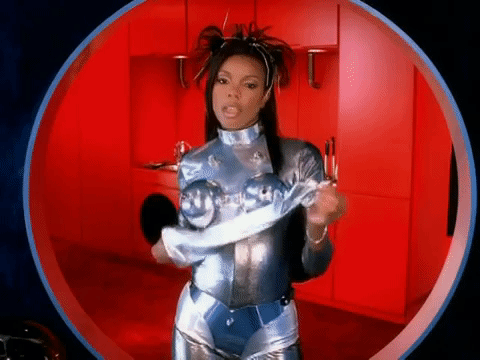2016 was the year that we all became acutely aware of the inherent chaos of the universe. Despite being armed with prestigious educations, insider knowledge, and all the professional expertise in the world, the people who were supposed to have all the answers got all the big calls spectacularly wrong.
To predict the future in such uncertain times is at best foolish and at worst hubristic, but there are, thankfully, a few comforting inevitabilities that we can rely on: just as dawn follows night and the summer withers into autumn, the fashion cycle will always turn back on itself. And now that the style industry has exhausted every last shred of nostalgia for the 90s, the Y2K era is next up for a revival.
The signs have been there for about a year now. Last winter was dominated by the puffer jacket, a trend that looks set to continue as the frost begins to bite at the ankles of 2017, if Supreme’s recently-unveiled metallic silver puffer — which looks like it’s been peeled straight off the backs of the Bomfunk MC’s — is anything to go by. Matrix-esque shades have been a recurring detail spotted on the catwalk at Balenciaga’s autumn/winter 17 and on the faces as varied as those of Georgian fashionistas and 032c fashion editor Marc Goering. The Air Max 97, a masterpiece of Y2K futurism, was recently reissued for the 20th anniversary of its release, while the Nike TN, another millennium-era icon, has been enjoying a resurgence of late.
It’s always odd to see the style of the past reanimated in the present day, but Y2K fashion feels particularly out of place in our modern context — it was the product of a very different set of historical circumstances, namely an enthusiasm for the future that seems so naïve now, after the big political ruptures of 2016 and 2017.
The Institute for Y2K Aesthetics, a nostalgic tumblr devoted to documenting the visual language of the period, describes it as “a time when the future was tight leather pants, silver eye shadow, shiny clothing, Oakleys, gradients and blobby electronics”. It was an optimistic time, the unstoppable march towards a universal liberal democracy was underway, technology offered promise of an easier future, and people were eager to abandon a century stained by two World Wars, multiple genocides and the ever-present, looming threat of nuclear holocaust, for what then promised to be a shiny new millennium.
The year 2000 was within touching distance and, although flying cars were still the preserve of sci-fi movies, people tried to will a mid-20th century vision of the future into being by dressing as though it were already upon us. Futurism always ends up looking laughably off in retrospect, but there’s something inherently progressive about trying to predict the future, and the fact that it was such a prevailing theme of the era just goes to show how boldly hopeful a time it was. Of course that all came to a screeching halt on September 11, 2001, when the sound of two planes crashing into the World Trade Centre shook us violently out of our Y2K daydream.

That, in many ways, is the moment when “the future” — or our new present, rather — truly arrived. It’s been downhill ever since: Afghanistan, the second Gulf war, recessions, Brexit, Trump — the 21st century promised land of the collective imagination never materialised. Technology, rather than being a liberating force as the tech utopians once prophesied, actually turned out to be quite oppressive: Instagram has been proven to wreak havoc with our mental health, the Snowden leaks outed Facebook as an Orwellian nightmare, our smartphones are essentially tracking devices. As we fret over Donald Trump’s access to the nuclear codes Dr. Strangelove looks less more prophetic than satirical. As such, instead of manifesting the future we cower in fear of it, terrified that AI will render our careers obsolete and that rising sea levels will finally drown our faint hopes of owning property in Zone 2.
These pessimistic circumstances are reflected in the current zeitgeist: irony, the prevailing tone of our time, is inherently reactionary. As this New York Times essay observes, “No attack can be set against it, as it has already conquered itself. The ironic frame functions as a shield against criticism … irony is the most self-defensive mode, as it allows a person to dodge responsibility for his or her choices, aesthetic and otherwise.” Conversely, the Y2K era was fundamentally candid, because anyone who attempts to predict the future risks opening themselves up to ridicule in the likely event that they are wrong.
Ugly fashion, which is so in vogue these days, is also a form of reaction; because rather than attempting to transcend prevailing beauty standards, it rails against them. It uses contrarianism to mask an in-built defeatism that’s very much of our time: facing such a frightening, uncertain future, one of the few things that we do know is that we will be the first generation since WWII to be poorer than our parents. The odds don’t simply seem stacked against us, they game feels rigged. Resisting pessimism in such circumstances is near enough impossible, so it should come as little surprise that our current zeitgeist doesn’t exactly fizzle with positivity.
Y2K fashion may jar with the present, but that’s precisely what makes its revival so appropriate: with the social and political outlook being as bleak as it is, we’re in desperate need of a source of escapism. Aping the millennium era and the carefree optimism that it embodied is a comforting roleplay at a time when it feels so much harder to move forward than look back, and we’d rather not make eye contact with the here and now.
